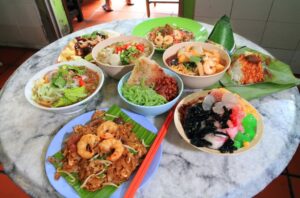Cuisine is not just a way of preparing food but also a reflection of the culture, history, and lifestyle of peoples around the world. In every corner of the planet, dishes tell their unique stories, weaving in traditions, climate, available ingredients, and even religious customs. Exploring the cuisines of different countries, we discover new flavors and learn about the lives of people living far from us. Interestingly, in today’s world, where technology makes our lives more convenient—including entertainment platforms like online casinos—the connection to culture through food remains one of the brightest ways to explore the world.
Mysteries of Eastern Cuisine
Asian cuisine amazes with its diversity and subtlety of flavors. Japan, for example, is famous for its ability to combine minimalism and sophistication. Sushi is not just food but an art, where every detail—from the quality of the fish to the shape of the roll—matters. The foundation of Japanese cuisine lies in the principle of freshness and seasonality of products. Chinese cuisine is known for its enormous variety of dishes, with unique spices and cooking techniques used in different regions. In Sichuan, spicy flavors are loved due to the large amount of chili peppers and Sichuan pepper, which creates a characteristic numbing sensation in the mouth. In southern China, a milder, sweeter taste predominates. Vietnamese cuisine is famous for its freshness and lightness, combining aromatic herbs, fresh vegetables, and fragrant broths.
European Traditions on the Plate
Europe offers a variety of cuisines based on a rich history and diverse climatic conditions. Italian cuisine is a true classic, where pasta, olive oil, fresh tomatoes, and aromatic herbs create an unmatched flavor. Italians carefully preserve recipes, passing them down from generation to generation, and each dish has its regional character. France is the cradle of haute cuisine and gastronomic art. Famous dishes such as ratatouille or bouillabaisse impress with their sophistication and complexity of preparation. Equally interesting is Scandinavian cuisine, where fish, fermented dairy products, and berries prevail. Such dishes are often associated with simplicity and naturalness, yet they carry centuries-old traditions.
African Cuisine: The Wealth of Flavors and Traditions
The African continent offers visitors an extraordinary diversity of tastes. In North Africa, in countries like Morocco, Algeria, and Tunisia, dishes rich in spices—cumin, cinnamon, cardamom, and saffron—create a rich aroma. Tagine is a traditional dish of stewed meat and vegetables, cooked in a clay pot of the same name. In West African countries, the diet is based on grains, legumes, and vegetables. Interestingly, fermentation is widely used in the region to prepare foods, which gives the dishes a special depth of flavor. East Africa is known for dishes with mango, bananas, and various types of meat cooked over an open fire.
South American Culinary Discoveries
Latin American cuisines surprise with brightness and richness of flavors. In Peru, for example, corn, potatoes, and chili peppers are actively used to create unique dishes like ceviche—raw fish marinated in lime juice with added pepper and onion. Mexican cuisine is one of the most popular worldwide, known for tortillas, various sauces, and spices. It reflects a mix of indigenous traditions and Spanish influence, creating a colorful and recognizable taste. Argentina is famous for its meat, which is grilled here as asado, becoming an integral part of the country’s cultural heritage.
Culinary Traditions and Modern Technologies
The modern world unites not only people but also traditions. Technology influences all areas of life, including gastronomy. Thanks to the internet and mobile devices, recipes and culinary secrets are accessible to everyone, and online platforms allow not only to learn how to cook but also to relax. For example, visiting the site slovenskecasino.net, which features verified online casinos, one can notice that virtual casinos are becoming part of entertainment culture. Thus, traditions and modern innovations create a unique blend where history and innovation go hand in hand.
The Influence of Culture on Cuisine
Food is a mirror of society. Religious beliefs, historical events, geography, and climate directly influence what and how people cook. For example, in India, most dishes are oriented towards vegetarianism, which is connected to religious traditions. In the Mediterranean, preference is given to olive oil and fresh products, reflecting the region’s climate and lifestyle. In northern countries, where it is cold and summers are short, the diet predominately includes fatty and caloric foods necessary to maintain energy during the cold season.
Familiarity with the cuisines of the world not only broadens the horizons of taste but also allows for a deeper understanding of the culture and mentality of different peoples. This journey is available to everyone—it is enough to discover new recipes, try dishes, or even learn more about the traditions behind them. Thus, flavor becomes a guide to history and traditions, while modern technologies and entertainment make this journey more exciting and accessible.



